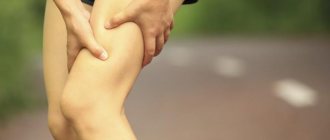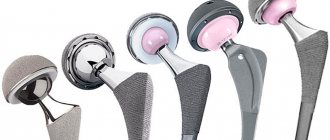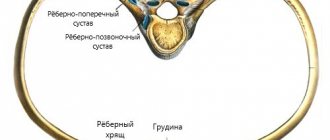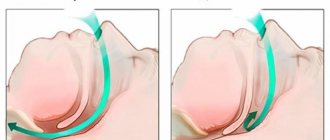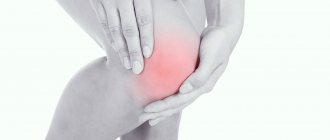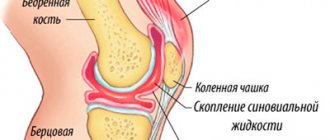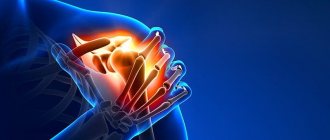JSC "Medicine" (clinic of academician Roitberg) operates a Pain Treatment Center. More details about the Pain Treatment Center
Pain in the hip joint, as a rule, indicates the appearance of a pathological process in the anatomical structures of the joint itself or adjacent tissues and organs. Most often, pain is caused by mechanical damage, an inflammatory process, an infectious or endocrine disease. It is possible that there are other factors that can trigger the appearance of this symptom. Let's look at why the hip joint hurts and how to deal with this problem.
Causes
Among the factors that provoke the appearance of pelvic pain, we should first of all mention:
- infectious inflammatory process in the tissues of the joint capsule (arthritis);
- degenerative tissue changes, osteoarthritis;
- traumatic injury - dislocation or fracture of the femoral neck;
- aseptic necrosis affecting the head of the femur;
- inflammatory process in the tissues forming the joint capsule (bursitis);
- non-infectious inflammation caused by an autoimmune disease;
- tuberculosis process;
- pregnancy.
Pain in the pelvic bones is much less common in young patients than in older people. In the older age category (over 60 years), it is periodically or constantly present in 60-60% of patients, while children under 18 years of age suffer from it in barely 10% of cases.
Characteristic and accompanying symptoms
Joint pain radiating to the leg is always accompanied by symptoms that indicate the nature of the pathology that caused it. Examples:
- Inflammation of other joints accompanied by elevated temperature is a sign of rheumatoid arthritis.
- Pain of an indeterminate nature, radiating not only to the leg, but also to the buttock, lower back and knee, is a signal of avascular necrosis (a very serious disease).
- If the discomfort increases gradually, covers the entire leg, intensifies during movement or when forced to sit still, and changes the gait, these are signs of arthrosis.
- The combination of pain radiating to the leg with lumbar pain indicates the development of radiculitis of the lumbosacral region.
Pelvic pain in women
The joint connecting the pelvic and femur bones bears the heaviest load in a woman’s body, so its wear and tear is also extremely high. A common cause of its damage is a fracture of the femoral neck - an injury that most often affects women over 60 years of age. At this age, many of them develop osteoporosis after menopause. Bones become fragile, and any fall from height can lead to a severe fracture. In old age, its treatment usually requires surgery.
Another disease that often affects women is coxarthrosis, which is characterized by the gradual destruction of interarticular cartilage tissue. One of the typical manifestations is pain in the hip joint when walking, which subsides with rest. In women, the disease begins during menopause and progresses steadily, sometimes leading to complete inability to move independently.
Causes of pain in the hip joint
Soft tissue injuries
The most common traumatic cause of pain is a bruise of the hip joint.
Occurs when falling on the side or a direct blow, manifested by moderate acute pain, which quickly becomes dull in nature, gradually decreases and disappears within a few days, in severe cases – weeks. Support is preserved, movements are slightly limited. Swelling is detected locally and bruising is possible. Damage to the ligaments of the hip joint is rare, usually the result of road accidents and sports injuries, accompanied by sharp pain, and sometimes a cracking sensation (as if tissue is torn). The pain decreases somewhat, then often increases again due to swelling. Swelling from the joint spreads to the groin area and thigh.
The degree of dysfunction in ligamentous injuries depends on the severity of the injury (sprain, tear, rupture), ranging from minor limitation to the inability to support the leg. The pain intensifies with deviation of the body, movements in the direction opposite to the damaged ligament.
Bone and joint injuries
Femoral neck fractures usually occur in older people as a result of domestic or street trauma. A characteristic feature, especially in the presence of osteoporosis, is the absence of intense pain and mild swelling. At rest, the pain is deep, dull, moderate or insignificant; with movement, the painful sensations sharply intensify. The support is sometimes preserved. A typical sign is the inability to raise a straight leg from a lying position (sticky heel symptom).
Pertrochanteric fractures are more often diagnosed in middle-aged and young people and develop as a result of high-energy injuries. Unlike cervical fractures, they are accompanied by unbearable, sharp, diffuse, deep pain. Then the pain decreases, but remains very strong and difficult to bear. The joint is swollen and bruising is possible. Movements are severely limited. Support is impossible.
Isolated fractures of the greater trochanter are rare, found in children and young people, and are formed by a fall, direct blow, or sudden muscle contraction. The pain is acute, very intense, localized mainly along the outer surface of the joint. Due to increased pain, the patient avoids active movements.
Hip dislocations occur during falls from a height, industrial and road injuries, and are manifested by unbearable acute pain, which almost does not decrease until reduction. The joint is deformed, the leg is shortened, bent at the knee joint, turned outward, less often inward (depending on the type of dislocation). Support and movement are impossible; when attempting to move, spring resistance is detected.
Fractures of the acetabulum develop in isolation or are combined with hip dislocations. Characterized by acute explosive pain deep in the hip joint. Subsequently, the pain subsides somewhat, but remains intense, making any movement difficult. The leg is shortened and rotated outward. Support is impossible.
Degenerative processes
With coxarthrosis at the initial stage, the pain is periodic, dull, of uncertain localization, appearing at the end of the day or after significant exertion, sometimes radiating to the thigh and knee joint. There may be slight, quickly passing stiffness at the beginning of movements. Subsequently, the intensity of the pain increases, painful sensations are noted not only during movements, but also at rest. After heavy exertion, the patient begins to limp. Movements are somewhat limited.
In severe coxarthrosis, the pain is deep, diffuse, constant, aching, twisting. They are disturbing both during the day and at night. Resistance to stress is reduced; when walking, patients rely on a cane. Movements are significantly limited, the affected leg is shortened, which leads to increased load on the joint and increased pain when walking and standing.
Chondromatosis of the hip joint in its course resembles subacute arthritis. The pain is moderate, diffuse, transient, combined with crunching and limited mobility. When intra-articular bodies are pinched, blockades occur, characterized by intense sharp pain, impossibility or significant limitation of movements. After the pinching of the articular mouse stops, the listed symptoms disappear.
Trochanteritis is usually formed with arthrosis of the hip joint, accompanied by inflammatory-degenerative damage to the tendons of the gluteal muscles at the point of their attachment to the greater trochanter, manifested by pain in the affected area when lying on the affected side. There is an increase in pain when trying to abduct the hip with resistance.
Bone nutritional disorders
Perthes disease develops in children and adolescents and is characterized by partial necrosis of the femoral head, which is initially accompanied by mild dull deep pain, sometimes radiating to the knee and hip. After a few months, the pain sharply intensifies, becoming constant, acute, and debilitating. The joint swells, movements are limited, and lameness occurs. Then the pain decreases, the degree of restoration of joint function varies.
Aseptic necrosis of the femoral head resembles Perthes disease in its course, but is detected in adults, has a less favorable course, and in half of the cases is bilateral. At first the pain is periodic, nagging. Then the pain intensifies and appears at night. At the height of clinical manifestations, the pain is so intense that the person completely loses the ability to lean on his leg. Then the pain gradually decreases. Limitations of movement progress over approximately 2 years, resulting in arthrosis of the hip joint, contractures, and shortening of the limb.
Solitary bone cysts form in the proximal metaphysis of the femur in boys 10-15 years old and are accompanied by mild, intermittent pain in the hip joint. Edema is usually absent; with prolonged course, contractures often develop, especially in young children. Due to mildly expressed symptoms, the reason for treatment is a pathological fracture or increasing limitation of movements.
Arthritis
Aseptic arthritis manifests itself as wave-like pain in the joint, intensifying in the early morning hours. The severity of pain varies from minor to acute, strong, constant, significantly limiting motor activity. Stiffness, swelling, redness, and increased local temperature are noted. Palpation is painful.
In rheumatoid arthritis, the hip joints are rarely involved, and the lesion is symmetrical. Periodic pain first appears during the changing seasons (autumn, spring), with a sharp change in weather conditions, during periods of hormonal changes after childbirth or during menopause. The pain is moderate or weak, diffuse, pulling or aching, sharply intensifies with palpation. Combined with recurrent synovitis, edema, hyperemia, hyperthermia, and increasing limitation of mobility.
Infectious arthritis develops when the infection spreads hematogenously or lymphogenously, or less commonly when the pathogen penetrates the joint from nearby tissues. Typically acute onset with rapidly increasing pain. The pain is intense, jerking, tearing, bursting, bothers you at rest, intensifies with movement, causing the limb to take a forced position. Patients exhibit fever, chills, sweating, severe weakness, swelling, redness of the joint, and increased local temperature.
In the absence of timely treatment, bacterial infectious arthritis can develop into panarthritis - purulent inflammation of all tissues of the hip joint. It is characterized by a severe course with very acute widespread throbbing pain, hectic fever, severe weakness, presyncope, significant hyperemia and hyperthermia.
Other inflammatory diseases
Osteomyelitis of the upper thigh can be hematogenous, post-traumatic or postoperative in nature. Hematogenous osteomyelitis is manifested by clearly localized, very acute bursting, tugging, tearing or boring pain, due to which the patient avoids the slightest movements of the limb. Severe hyperthermia and severe intoxication are noted.
Post-traumatic and postoperative osteomyelitis occurs with similar, but less pronounced symptoms. Typically a more gradual onset against the background of an open fracture or postoperative wound, the appearance of purulent discharge. Pain in the hip joint increases over 1-2 weeks in parallel with the progression of signs of local inflammation.
Synovitis develops against the background of injuries, other diseases of the hip joint, and less often becomes a manifestation of allergies. In acute synovitis, the pain is usually minor, dull, bursting, gradually increasing due to an increase in the amount of intra-articular fluid. The joint is swollen, palpation is slightly painful, and the symptom of fluctuation is determined. Chronic synovitis is asymptomatic and is accompanied by mild aching pain.
With intermittent hydroarthrosis, the pain is also minor, accompanied by discomfort, limited mobility, and disappears within 3-5 days after reverse resorption of the effusion. They recur at certain intervals, individual for each patient, and are caused by repeated accumulations of fluid in the joint.
Specific infections
Tuberculosis of the hip joint is a common form of osteoarticular tuberculosis, which manifests itself with general weakness, fatigue, and low-grade fever. Then weak pulling or aching pain in the muscles appears, and transient painful sensations in the joint when walking. The patient begins to spare the limb. As the pain progresses, it becomes moderate, diffuse, extends to the knee, and is accompanied by swelling, redness, and synovitis. A protective contracture develops.
Pain in the joints, including the hip, can appear with brucellosis. In acute and subacute forms, painful sensations are pulling, twisting, and are combined with periodic fever, lymphadenopathy, and skin rashes. In the chronic course, the pain syndrome resembles that of aseptic arthritis, and deformities form over time.
Congenital anomalies
Manifestations of hip dysplasia are determined by the degree of incongruence of the femoral head and acetabulum. With complete congenital dislocation, pain appears immediately after the child begins to walk and is accompanied by lameness. With moderate subluxation, pain occurs at the age of 5-6 years and is directly related to the load on the leg.
With mild subluxation, the pathology is asymptomatic for a long time, pain syndrome manifests itself with the development of dysplastic coxarthrosis at the age of 25-30 years. Distinctive signs of such arthrosis are a rapid increase in pain, early onset of pain at rest and at night, and progressive limitation of movements. All forms of dysplasia are accompanied by asymmetry of skin folds, a “clicking” symptom and limited mobility. In case of dislocation, shortening of the limb is noted.
Neoplasms
For benign neoplasia, an asymptomatic course is typical. The pain is minor, intermittent, and often does not progress over many years. Tumor growth is accompanied by a slow increase in pain and recurrent synovitis. In the area of the hip joint, osteomas, osteoid osteomas, osteoblastomas, and chondromas are more often detected.
Malignant neoplasias (osteogenic sarcomas, chondrosarcomas) are characterized by rapid progression of pain and other manifestations of pathology. At first, the pain is minor, short-term, without a specific localization, sometimes intensifies at night. Subsequently, they become sharp, permanent, cutting, encircling, and spread to the entire joint. The affected area swells and becomes deformed. Weight loss, weakness, and low-grade fever are noted. With advanced neoplasia, the pain is excruciating, unbearable, and can only be eliminated with narcotic drugs.
Other reasons
Pain in the hip joint sometimes appears with lumbosacral plexitis and sciatic nerve neuropathy, but they usually occupy an insignificant position in the clinical picture of the disease and fade into the background compared to intense pain in the back of the buttock and thigh, limb weakness and sensory disturbances.
Pain syndrome in this localization is often detected with osteochondrosis and disc herniations. Painful sensations can be detected with spondylitis, deforming spondyloarthrosis and spinal curvature. The pain is dull, periodic, aching, often intensifying during the period of exacerbation of the underlying disease. The reason for their appearance may be constant overload of the joint or the development of coxarthrosis.
Sometimes joint pain is caused by mental illness or depressive disorder. Diabetes mellitus is often accompanied by enthesopathies, capsulitis, and other lesions of periarticular soft tissues. Drug-induced arthropathy is possible when taking certain medications.
Pelvic pain in men
The only pathology of the pelvic joint that affects only men is Perthes disease. This is a hereditary disease that consists of deformation of the head of the femur: it becomes flat rather than round. When walking, the patient has pain in the hip joint on the left side, if the pathology is localized on the left, or on the right side, if the head is deformed on the right.
A disease that is more common in men is tendonitis, or an inflammatory process that affects the tendons. This is a disease of athletes and people forced to perform heavy physical work for a long time - loaders, masons, heavy weights, etc. Pain appears during heavy exertion, during active movements. With moderate and light loads, as a rule, there is no pain.
The next typically “male” disease is necrosis of the femoral head, and about a third of patients become ill at a young age - up to 30 years. The disease goes through several stages, and already at the very beginning the patient has pain in the hip joint on the right side (or on the left), and the pain is felt in the groin area, less often it radiates to the hip, knee or lower back. If left untreated, lameness appears over time and disability develops.
Joint diseases and their characteristic symptoms
Often the spine ache very much precisely because of problems with bones and joints. These factors are the most common cause of discomfort. Moreover, both injuries and diseases of the musculoskeletal system can cause such a problem.
Joint diseases that cause pain in the joint:
- With osteoarthritis, pain mainly occurs in the morning. It gradually fades away over the course of the day. However, it returns under load. The more advanced the stage of the disease, the longer the pain syndrome does not go away.
- Bursitis makes itself felt with cramping pain. With this problem, it seems that the discomfort comes from deep within the tissues.
- Coxarthrosis is typical for older people. For a long time, this disease makes itself felt by pain only while walking. And only after severe destruction of the joints does it begin to manifest itself at rest.
- With arthritis, discomfort is expressed by severe aching pain.
- When the ligaments become inflamed, the pain is very pronounced and painful. They appear at the slightest load.
- Neuralgia of the cutaneous femoral nerve is expressed by severe and burning pain. The thigh and buttock may also ache.
In addition to painful symptoms, some other signs can indicate the presence of problems with the joint. Among them are a crunch in the joint, loss of flexibility and mobility of the back, general or local temperature, and a change in gait.
Pelvic pain in pregnant women
There are several reasons why hip joints may hurt in women:
- in recent weeks - lack of calcium or vitamin D;
- increased production of the hormone relaxin, which promotes sprains;
- exacerbation of latent hip dysplasia or osteoarthritis;
- increased stress on the joint due to weight gain;
- old injury.
Women who have pelvic pain during pregnancy should be more attentive to their health, because this condition can lead to an exacerbation of even minor diseases.
How should the pathology be treated?
If you periodically feel pain in the hip joint, it must be treated. Therapy depends on what caused it. So, treatment of the joint occurs depending on the pathology.
Congenital dislocation
If the dislocation is congenital, the child is given special orthopedic products on the joint: stirrups, spacers, or a Freik pillow is recommended. All these means support the legs of a newborn baby in the correct physiological position. The child will have to stay in them for at least six months. If traditional treatment is not effective, then the baby is prescribed surgical intervention. That is, the head of the femur is surgically reduced to a newborn child, and other defects are also corrected. After the orthopedic devices are removed, your baby can be given a gentle massage to strengthen the muscles.
Traumatic dislocation
If there is a traumatic dislocation, the doctor will have to use medications that help eliminate muscle tone to set it back. After this, the patient needs to be kept at rest. Numbness in a limb indicates a pinched nerve. This will require a mandatory examination by a neurologist.
Femoral neck fracture
Treatment of a femoral neck fracture is carried out by a traumatologist. With such damage, surgery is indicated for the patient. Conservative treatment methods are sometimes ineffective. But if the operation cannot be performed, then the patient is recommended to apply a plaster bandage to the left (right) leg, from the lower back to the heel. In women or men over 60 years of age, such damage to the hip bone rarely heals, and the recovery process takes months. Among the consequences of this disease, one can highlight the insufficient functionality of the respiratory and cardiovascular systems, because the patient is not able to lead an active life and move normally. Even sitting becomes a problem for him. A fracture of the joint may be accompanied by a burning sensation in the soft tissues. As for surgery, in this case the treatment uses fixation of the head and body of the bone with pins or screws, as well as endoprosthetics.
Bechterew's syndrome
Treatment of ankylosing spondylitis is complex. It helps reduce the intensity of symptoms caused by inflammation. Therapy includes medications (anti-inflammatory drugs, hormonal drugs, immunosuppressants), physiotherapeutic procedures, therapeutic exercises (muscle stretching is useful). Massaging the affected joint on the left or right is considered equally useful. All medications, as well as therapeutic exercises, are selected strictly by a traumatologist, orthopedist or surgeon. To strengthen your pelvic muscles, you need to go swimming. In particularly difficult cases, the patient is advised to undergo arthroplasty on the left or right.
Reiter's disease
To treat Reiter's pathology, you will need antibiotics, as well as anti-inflammatory drugs, glucocorticosteroids, drugs to suppress the function of the immune system, and local ointments. Treatment will take a long time - at least 4 months. It should be noted that the presented pathology can recur in half of the cases. During treatment, it is necessary to maintain muscle tone with physical exercise - regular stretching.
Rheumatoid arthritis
Rheumatoid arthritis, which can cause severe pain even at rest, cannot be completely eliminated. But you need to try to improve the quality of life of a sick man or woman. For this purpose, drug treatment is used with cytostatics, hormonal agents, non-steroidal anti-inflammatory drugs, as well as antirheumatic drugs. As for surgical intervention, it is used only in the last stages, when walking and sitting are practically impossible. Fixation or arthroplasty of the joint is recommended. Physical exercise, especially stretching, and topical ointments are also helpful.
You can also learn about the endoprosthetics procedure in this video:
Coxarthrosis
Treatment of coxarthrosis is aimed at eliminating the cause of the development of symptoms and signs. Pathology in the first stages of development is treated using conservative methods. The patient is prescribed NSAIDs (Diclofenac, Ibuprofen), chondroprotectors (Arthra, Dona), as well as medications to improve blood circulation. Painkillers and warming ointments are used for treatment. Additionally, the patient is prescribed light therapeutic exercises. Naturally, the joint often needs to be numbed. In case of severe discomfort, injections are used.
The last stage of coxarthrosis is no longer amenable to conservative therapy. Any load on the joint worsens a person’s well-being. Getting out of bed without assistance is impossible. The patient has to receive painkilling injections. In this case, the disease can only be treated surgically. Generally, joint replacement is required, however, it is contraindicated for very elderly people. Therefore, only auxiliary operations are performed on such patients. After surgical treatment, the patient requires a recovery course: light stretching, very simple exercises under the supervision of a doctor. The load should be minimal.
Proper therapy will help to somewhat slow down the progression of the disease, as well as eliminate unpleasant signs.
Features of the treatment of infectious and inflammatory pathologies
It all depends on the type of disease:
- Purulent arthritis. First, the patient needs to numb the affected hip joint. For this, an analgesic injection directly into the joint can be used. The infection must be fought with antibacterial agents and antibiotics. Moreover, several groups of drugs are used simultaneously. Only a doctor can prescribe them. Additionally, ulcers are removed. The sore leg should be completely at rest, that is, the patient is given a plaster cast or splint.
- Treatment of aseptic necrosis of the femoral head involves restoring blood flow and rapid resorption of areas that have become necrotic. The limb should be numbed with NSAIDs. Vitamin complexes and drugs to reduce blood viscosity are also used. If the hip continues to ache, then you should additionally apply a massage and anesthetic ointment. This disease can also be treated with physiotherapeutic procedures and therapeutic exercises. In difficult cases, minimally invasive surgical techniques or joint replacement are used.
- Since bursitis causes severe pain in the hip joint, it must be numbed. For this, an analgesic and anti-inflammatory agent is used, and it is administered through an intramuscular injection. Steroids are also used to quickly relieve severe discomfort. Since the thigh and hip joint can constantly ache, she should be given rest.
- Tuberculous arthritis is treated primarily conservatively. The baby needs to limit his mobility with a tight bandage. If a child develops an abscess in the soft tissues, it should be removed surgically.
Burning sensation, numbness of the limb, pain in the hip joint, radiating to the leg - these are unpleasant sensations that indicate the possible presence of serious problems.
Osteopathic doctor Evgeniy Lim tells how to treat painful sensations:
Traditional treatment for pain in the hip joints
If a person has burning pain, problems with tendons, but it is not advisable for him to take pills, then folk remedies can be used. They cannot be called a panacea, but they help in complex treatment. Naturally, you should consult a doctor before use.
The following folk recipes will be useful:
- Clay compress (blue, white). This folk remedy helps relieve swelling and pain. It is better to alternate clay. The clay should be applied overnight and wrapped in a warm cloth.
- Cabbage compresses. They will also need honey. It is smeared on a cabbage leaf and applied to the place where burning or acute pain is felt. Next, the compress is covered with a plastic bag and insulated with woolen cloth. The course of treatment is 1 month. In between compresses, you can do a light massage on the affected hip joint: rubbing, stroking.
- Homemade ointment from interior fat and white foot root (250 g). The fat must be melted, add the root chopped in a meat grinder and put on low heat. Boil the mixture for 7 minutes. After the ointment has cooled, apply it to the affected hip joint at night. In this case, the joint must be insulated. This folk remedy relieves swelling and other unpleasant symptoms well.
- A peculiar folk remedy made from garlic, celery and lemon, which relieves severe pain in the tendons. For preparation you will need 2 lemons, 300 gr. celery root, as well as 130 gr. garlic All ingredients are thoroughly ground in a meat grinder and placed in a container with a tight lid. Next, the entire mixture is poured with boiling water and mixed. Now you need to cover the product tightly, wrap it with a blanket and leave it overnight. The medicine should be taken one teaspoon before meals for several months.
These remedies cannot eliminate a pinched nerve of the hip joint. Numbness of a limb should alert you and force you to consult a neurologist. Any lesion of the hip joint that causes pain must be identified and treated in a timely manner. Light gymnastics and stretching exercises will help prevent the development of dysfunction of the hip joint.
Elena Malysheva and her experts talk more about the disease in this video:
Chronic pelvic pain
Chronic is any pain in the pelvic area that continues with varying intensity for several months. Aching pain in the hip joint and surrounding area often occurs in women, but men also suffer from diseases that cause pain in the pelvic area. The causes of pain are varied, from osteochondrosis to urological and gynecological diseases. In each case, a thorough examination is necessary to identify the disease and prescribe adequate treatment.
How to understand that you have coxarthrosis
At different stages of the disease, pain has different intensity. Initially, the patient periodically feels aching pain after exercise, which is more pronounced in the groin. In the second stage, it increases and does not stop at night. Movement is somewhat limited, and there is a characteristic swaying or limp in the gait. As a rule, at this stage the person already has a clearly defined diagnosis and is undergoing treatment.
If this does not happen, the joint becomes completely motionless, and the limb is significantly shortened. Conservative treatment rarely helps - surgery is necessary.
Most people understand that they have coxarthrosis only at stage 2
Diagnostics
To determine the disease that causes constant pain in the hip joint, it is necessary to undergo a fairly extensive examination, which includes:
- X-ray of the hip joint, which allows you to detect or exclude traumatic damage, identify bone defects, growths and other pathologies;
- Ultrasound of the hip area, which reveals inflammatory processes and degeneration of soft tissues, calcified areas and other pathologies;
- CT scan of the hip joint, which is prescribed to clarify the diagnosis or in unclear cases;
- MRI to clarify the condition of the soft tissues of the joint capsule;
- puncture of joint fluid to remove effusion and study the composition of the infiltrate in order to detect the causative agent of infection;
- joint arthroscopy - endoscopic examination of the joint capsule using a probe inserted through a small incision.
In addition, the orthopedist, surgeon or rheumatologist prescribes laboratory tests for the patient in accordance with the presenting symptoms:
- general urine and blood tests;
- immunological blood test;
- biochemical blood test for rheumatic markers, etc.
general description
Aching pain in the right or left hip joint is usually associated with inflammation, pinching or irritation of the sciatic nerve. Moreover, it can radiate to the leg, thigh and buttock. This pain is especially pronounced when walking and exercising.
This is interesting! Sciatica is called pain in the right or left hip joint, which radiates to the leg and buttock and is caused by pinching or inflammation of the sciatic nerve.
This pain often spreads from the hip joint and tailbone, gradually moving to the gluteal muscle, the back of the thigh and calf, integrating into the foot, but not affecting the toes. Thus, it spreads throughout the lower limb. Usually this sensation affects only the right or left side. But in some cases it can affect both limbs at once.
This symptom often affects the general condition and gait of a person. The patient experiences severe discomfort while walking and, trying to reduce the load on the affected limb, begins to limp.
Integrating pain
Treatment
Clinic JSC "Medicine" offers the services of the "Pain Treatment Center". Experienced specialists will help solve the problem with any type of pain.
Since there are quite a lot of diseases that cause pelvic pain, the methods of treating them depend on the symptoms and disorders detected during diagnosis. For pathologies of bone and joint tissue, the following are usually prescribed:
- chondroprotectors, complexes of minerals and vitamins to strengthen bones, cartilage tissue and ligaments;
- muscle relaxants to reduce muscle spasms and relax tense muscles;
- non-steroidal anti-inflammatory drugs, in case of severe symptoms - steroids;
- drugs that improve capillary circulation to reduce swelling and manifestations of hypoxia;
- diuretics to stimulate fluid exchange and reduce swelling.
For inflammatory diseases, physiotherapeutic sessions have a good effect. Patients are prescribed electrophoresis, laser therapy, medicinal phonophoresis and other procedures. They are carried out at the end of the acute phase of inflammation to stimulate the recovery process.
If conservative methods are not effective enough, the patient may be prescribed:
- therapeutic blockade - the introduction of an anesthetic drug into the selected area to block the transmission of pain impulses along the nerve fiber, due to which spasmed muscles relax, the trophism of periarticular tissues improves, and blood flow normalizes;
- radiofrequency denervation - elimination of nerve fibers using a radiofrequency pulse through needles inserted into the joint tissue, which allows the patient to permanently relieve pain in the hip joint, radiating to the groin, knee or lower back;
- surgical opening and drainage - for purulent inflammation of the joint, followed by antibacterial therapy;
- removal of the tumor - in case of a malignant tumor process, after which chemical and radiation therapy is carried out to reduce the risk of relapse;
- hip replacement - in case of destruction, the head of the femur is removed and an implant is installed in its place, but in some cases not only part of the femur is replaced, but also the acetabulum of the pelvic bone.
The choice of method depends on the degree of damage to the joint and other tissues.
Types of pain
Back pain when walking can have different severity and character. It depends on what caused it, as well as on the pain defect of a particular person and on the neglect of the problem.
The pain may be severe or mild. They also distinguish between the aching, sharp, stabbing, dull and pulling nature of this sensation. When visiting a doctor, you should try to describe exactly what type of pain is inherent in a particular case.
Types of painful sensations:
- Acute pain is very intense, but does not last long. Moreover, it is felt most strongly in the problem area; this sensation passes to the leg and buttock in a weaker form. The easiest way to deal with such discomfort is to deal with it.
- With aching pain, the sensation quite evenly integrates into the limbs located near the site of the lesion. The pain may ache and drag. This makes diagnosing the problem difficult.
- Chronic pain syndrome is the most painful. It may be present continuously for several months. Treatment of such discomfort is the most difficult.
Types of pain
Prevention
To avoid diseases that cause pain in the hip joint, you must:
- adhere to healthy eating principles, monitor body weight;
- maintain moderate physical activity, walk regularly;
- avoid heavy loads associated with lifting and carrying heavy objects;
- protect joints from hypothermia;
- avoid injury.
In what cases do you need urgent help from a specialist?
If you feel pain in your hip, monitor your condition. Perhaps the pain syndrome arose due to physical activity and after rest everything will go away. You can help yourself in such cases with the help of pharmaceutical ointments.
An examination by a specialist is urgently needed if:
- there is a visible deformity of the hip joint;
- you can't move your leg;
- the pain is so severe that it prevents you from stepping on your full foot;
- leg is swollen;
- the pain arose against the background of high fever and an infectious disease.
If you are unable to walk normally due to hip pain, see an orthopedist immediately
